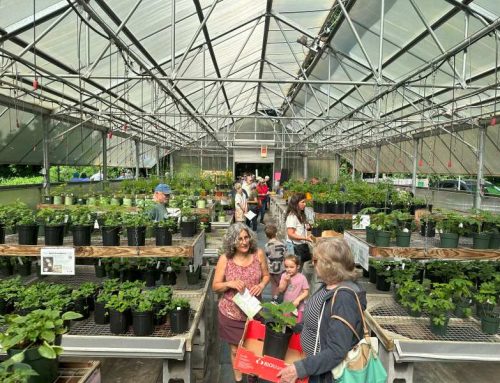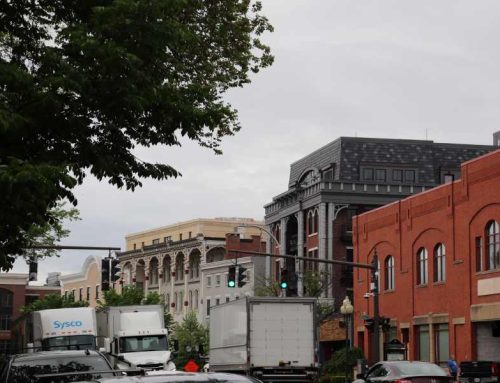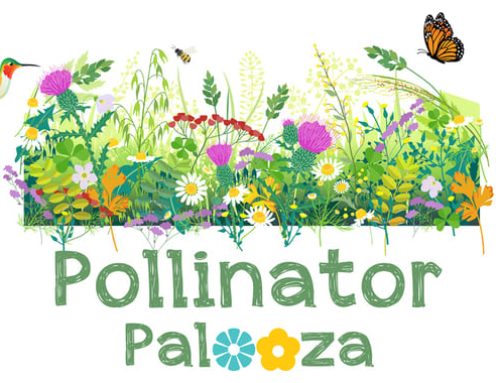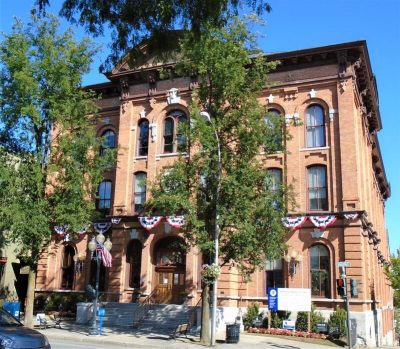
Sustainability in Saratoga Springs:
Interview with Jason Golub, DPW Commissioner
As the Commissioner of Public Works for Saratoga Springs, Jason Golub oversees the city’s Department of Public Works, which employs about 130 people and has a budget of roughly $130 million. An attorney who lives in Saratoga Springs, Golub was re-elected in November 2023 for his second two-year term. He recently sat down with Elaine McArdle, a board member of Sustainable Saratoga, to discuss his priorities for sustainability in the city.
What is your vision as DPW commissioner?
I came in with the idea that DPW is more than plowing your snow and picking up leaves. My idea is that it should be the future vision of what our city will look like – the infrastructure, the bike lanes, the trails. To me that’s where DPW can drive change while doing the core responsibilities of maintaining our city streets, our water, our sewers.
Are there sustainability-focused projects that have taken place under your leadership at DPW that you would like to highlight?
Developing new parks, because new green space is high on my to-do list. Last year we developed Flat Rock Park [on High Rock Avenue] next to the City Center garage. We’re doing another park this year on Excelsior Avenue by the water treatment plant, a two-acre park with a pollinator garden and community garden. In our tree-planting program, I’ve asked the arborist to focus on lower-income areas that don’t have as much tree coverage, and we’re working on affordable housing, which is tangentially related to sustainability. We’re also working on the advancement of the Complete Streets Plan, with more trails and sidewalks, for example sidewalks near Caroline Street Elementary School, and we’re doing another one on Grand Avenue on the West Side. We want more walkability and connectability of our city. I’m definitely committed to that, and my biggest issue is doing that in a way that makes sense for the city and connects the city; for example, there’s a bike lane on Lake Avenue that doesn’t connect to anything. So bringing connectivity through Complete Streets is important, and I’m a huge proponent of supporting green space and expanding our green space.
What about recycling?
We are still rolling out a city recycling program. The city doesn’t have one now, although we have a pilot program in city hall. We’ve ordered a truck that will allow us to collect recycling and garbage, so we can collect from city buildings, and we’ll put recycling bins on Broadway and other main streets; we have them at Flat Rock Park, but we want to expand that. We’re supposed to have the truck by the end of the year.
What projects are underway to help Saratoga adapt to extreme weather events such as intense downpours and extreme heat that are occurring more frequently due to climate change?
Extreme weather is an issue for DPW. We have more weather-related emergencies, more flooding. I’ve been here just two years, but I was just talking to a guy who’s been here 20 years, and whether it’s rain storms or more intense flooding in the streets, there’s a lot more happening with regard to climate. In the summer of 2023, the first two months were completely dry and then it poured the rest of the summer. Those first two months were a real concern.
What, if any, additional resources do you think DPW might need to address climate mitigation and adaptation to protect residents and city operations from the impacts of climate change?
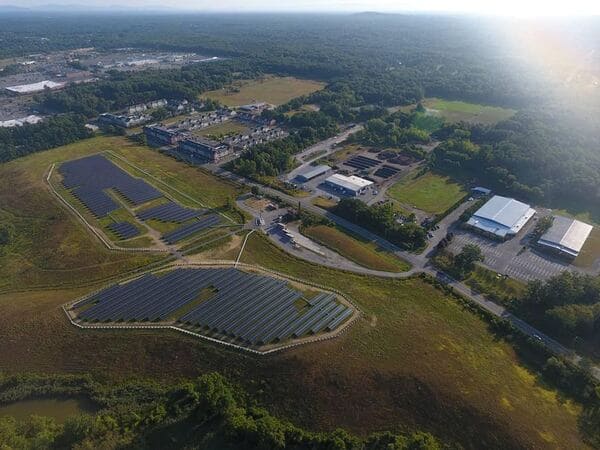
Spa Solar Park
As the city continues to expand, DPW needs more resources to keep up: more [workers] but also more strategies, thinking holistically about what makes the most sense for our city given climate change. Take the water management program: What does it look like for the next 20 years? [This approach] means having a long-term view rather than just planting 10 trees. It’s the same with affordable housing; it’s great to put it up, but if you do it without sidewalks, trails, bike lanes, does it support the ecosystem? The same with sustainability: as you develop more, are we still the “city in the country”? And what is that balance? So you need to be thoughtful about having a long-term vision that balances sustainability. What we don’t want to become is an urban jungle — that’s the critical piece. So you can take any element; say, our [DPW vehicle] fleet. We’d like to migrate our fleet of trucks and cars to electric; that’s part of the climate conversation, it’s part of sustainability. But you need a long-term plan to do it. Sometimes you just need a new vehicle tomorrow, so you have to balance that with a long-term vision of what the city wants to look like.
I do not like task forces. What I like is getting things done. What do we actually accomplish with the resources we have? A lot of times task forces postpone decision points. Someone has to make a decision.
The City already has a convenient curbside composting program for yard waste. Are there plans to add food waste to the City’s composting program?
We’ve thought about it but not at least from the DPW perspective. We just don’t have the infrastructure to support it.
Tell us about the DPW Helping Hands program, which you created to hire unhoused people to work for DPW.
This year we started the DPW Helping Hands program, where we’re hiring homeless individuals. We had a big problem with homeless at the garage [on Long Alley]. Now we have a homeless shelter, but that’s only one piece of the puzzle. Now that they have a roof over their heads, how do we employ them? We employ them at DPW, working on our various teams. The first person we hired is painting fire hydrants. It gives him an opportunity to be employed; he hadn’t been employed in 10 years. We’ve employed four people so far, and we want to expand it. The idea is that they stay in the program until they can roll into the private sector and get jobs there, and new folks can come in. It’s not something you stay in forever, it’s six months of solid employment for the city and a reference, and that’s a big difference. Then they can afford housing because they’re getting a paycheck.
We are, again, trying to expand what DPW is doing for the community. The problem with homelessness isn’t even just homelessness, it’s mental illness, it’s drug addiction, it’s lack of employment, lack of housing. They’re all connected, and you can’t expect a solution if you don’t think about all those levels.
What makes Saratoga Springs special?
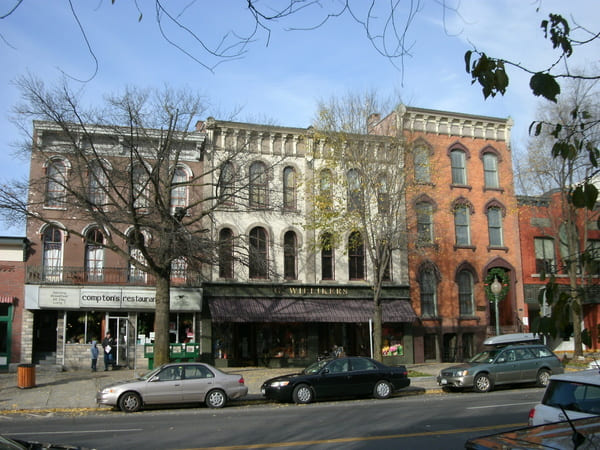
Photo credit: Doud Kerr
I love Saratoga. It is that “city in the country” feel. I can be in the woods on trails in five minutes or downtown at great restaurants hanging out with friends. I lived in New York City for 10 years before here, and I like the pace here, the quiet, the people. My focus is always on the people who live here, not the people who visit here. First and foremost, how do we make this a wonderful place to live?
You oversee a large department. How do they view their work?
The people who work for DPW take real pride in it. There are people who’ve spent their whole careers in DPW, their whole lives. I hate the cliché, “It’s like a family,” but it is, and that’s why people want to work for DPW because it does have that feel, and also that pride of making the city beautiful. The flower crew love it when people stop and say, “Broadway looks amazing,” and people [say that also] when the holiday decorations go up. I think I have the best team.
What is your greatest goal and hope?
What I said before: that people see DPW as more than just a department that picks up leaves but as a department that drives the future of our city, particularly for our residents. We want this to be a really great place to live, so sustainability goals, whether it’s parks or bike lanes, all fall within DPW. We want to be seen as thoughtfully driving positive change for the city.

